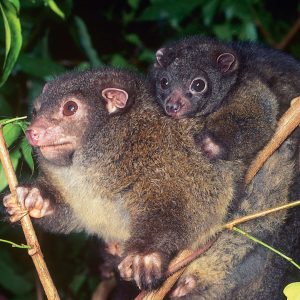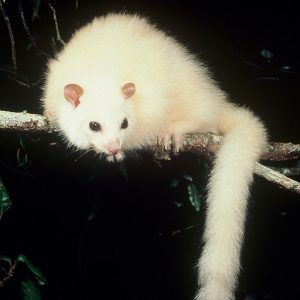Critter Corner – Lemuroid Ringtail Possums
 #CritterCorner – The Lemuroid Ringtail Possums (Hemibelideus lemuroides) lives in the Wet Tropics regions of far north Queensland. If you’re in the area, look high up in the trees and you may just see them leaping up to 2-3 metres in distance from branch to branch. During the day, they take shelter in tree hollows but when nightfalls, they emerge and leap noisily about the canopy.
#CritterCorner – The Lemuroid Ringtail Possums (Hemibelideus lemuroides) lives in the Wet Tropics regions of far north Queensland. If you’re in the area, look high up in the trees and you may just see them leaping up to 2-3 metres in distance from branch to branch. During the day, they take shelter in tree hollows but when nightfalls, they emerge and leap noisily about the canopy.
And yes, they’re pretty cute. They generally have brown-grey to chocolate brown body fur, with a creamy yellow underneath, however there some are white all over. Lemuroid ringtail possums are similar in size to a common ringtail possum, and weigh between 750 and 1100 grams. They grow until they achieve 30 to 38cm in length with a brushy 30-35cm long tail. They are ‘folivores’, meaning they primarily eat leaves. Their favourite foods are young leaves from the Qld maple, brown quandong or bollywood trees, but they will also eat mature leaves from these types of trees before moving on to other tree species. Occasionally they indulge in flower buds from the brown bollywood and the covering of yellow walnuts.
 The Lemuroid ringtail is a social species, occurring in pairs or in family groups. Breeding occurs between August and November with the female giving birth to a single young. The dependant young remains with the mother until as late as the following April, after which they become independent.
The Lemuroid ringtail is a social species, occurring in pairs or in family groups. Breeding occurs between August and November with the female giving birth to a single young. The dependant young remains with the mother until as late as the following April, after which they become independent.
Climate change has been suggested as a key threatening process to the lemuroid ringtail possum. The white Lemuroid ringtail possum is vulnerable at temperatures above 30°C and cannot survive at temperatures above this for more than 4 or 5 hours. Due to their restricted habitat in cool, moist, high altitude forests, any increase in temperature will impact their ability to maintain their body temperature and will also further reduce their available habitat.
Sources: Qld Department of Environment and Science. Photos courtesy of WTMA.
Want more good Rainforest news in your life?
Subscribe to our eNews | Follow us on Instagram | Like us on Facebook | Subscribe to our YouTube channel
Help Protect Rainforests Forever
Donate to Protect Rainforests Forever | Become a Rainforest Guardian for as little as $2 a month | Partnership Options

